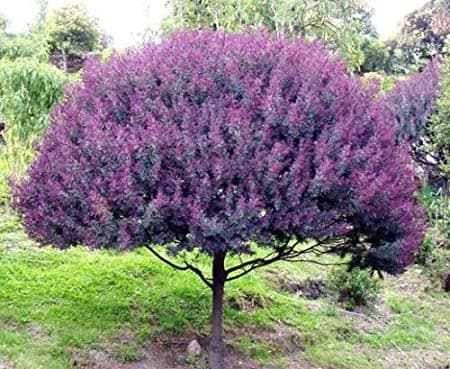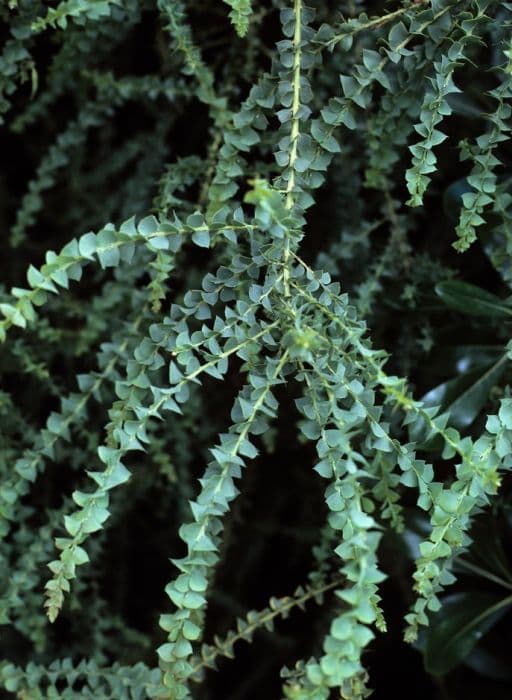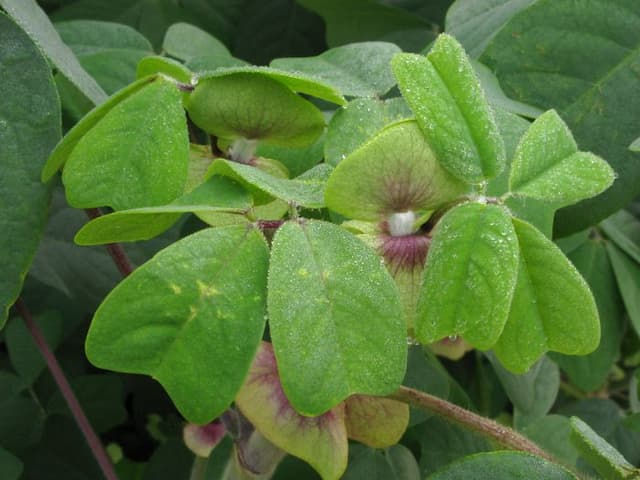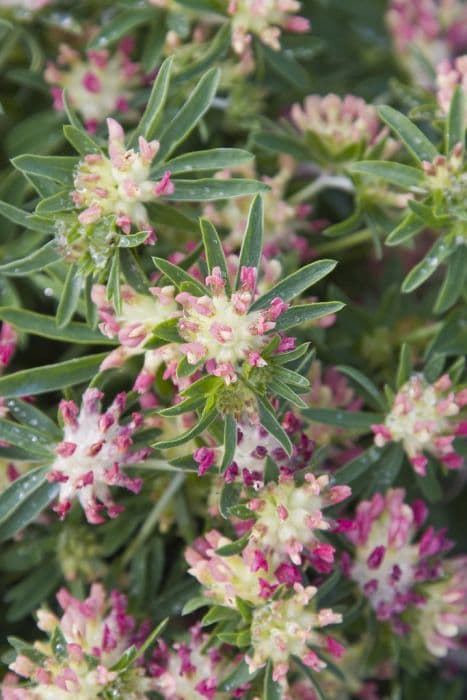Lupine Lupinus 'My Castle' (Band of Nobles Series)
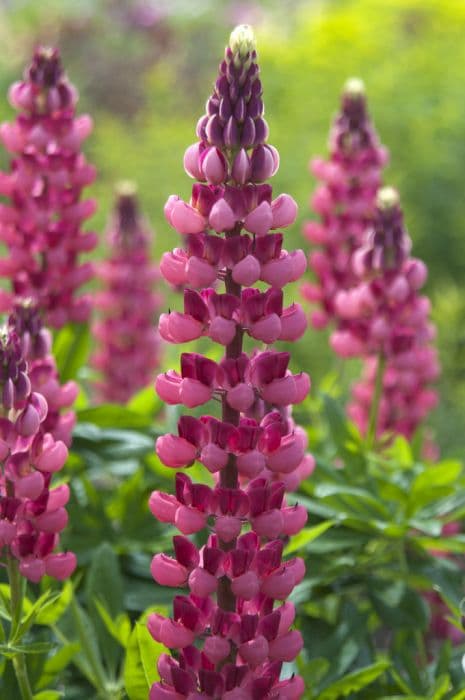
ABOUT
The Lupinus 'My Castle', which is part of the Band of Nobles Series, is a striking perennial known for its beautiful, tall spires of flowers. Its flowers come in a warm, rich shade of red, exuding an aristocratic charm that perhaps inspired its name. The blooms are densely packed around each spike, creating a lush, full appearance that stands out in any garden display. The foliage of this Lupinus consists of palmate leaves, which means the leaves are arranged in a circular pattern that resembles the palm of a hand. Each leaf radiates outwards, comprising several narrow, leaflets with a smooth or slightly hairy texture, adding to the plant's overall feathery effect. This variety, like other members of the Band of Nobles Series, is cherished not just for its aesthetic appeal but also for its capacity to attract pollinators like bees, butterflies, and hummingbirds, which are enchanted by its vibrant display and intricate flowers. The leafy structure at the base of the plant provides a lush green contrast to the striking flower spikes, giving it a robust and full-bodied appearance in the landscape.
About this plant
 Names
NamesFamily
Fabaceae
Synonyms
Lupin, Lupine
Common names
Lupinus 'My Castle'
 Toxicity
ToxicityTo humans
Lupines, including Lupinus 'My Castle', contain alkaloid compounds that can be toxic to humans if ingested. These toxins are primarily found in the seeds and can cause symptoms that range from mild to severe, including digestive upset, trembling, weakness, confusion, and potential respiratory problems. Rare cases can lead to more severe reactions, such as convulsions or coma, particularly when larger quantities of seeds are consumed. Medical attention should be sought if ingestion occurs, or if symptoms manifest after handling the plant.
To pets
Lupines are toxic to pets due to their alkaloid content. In dogs and other pets, ingestion of lupine parts, especially the seeds, can lead to similar symptoms as in humans, such as vomiting, diarrhea, lethargy, and in severe cases, more serious neurological effects like tremors and convulsions. If a pet ingests lupines, prompt veterinary care is advised to mitigate the potential risks of poisoning.
 Characteristics
CharacteristicsLife cycle
Perennials
Foliage type
Deciduous
Color of leaves
Green
Flower color
Red
Height
3 feet (0.91 meters)
Spread
2 feet (0.61 meters)
Plant type
Herb
Hardiness zones
4
Native area
Mediterranean
Benefits
 General Benefits
General Benefits- Attracts pollinators: Lupinus 'My Castle' is known to attract bees, butterflies, and other beneficial insects, which can help pollinate garden flowers and crops.
- Nitrogen fixation: As a member of the legume family, it has the ability to fix nitrogen from the air into the soil, improving soil fertility.
- Aesthetic appeal: The vibrant spikes of red flowers, characteristic of 'My Castle', add height and color to garden borders.
- Erosion control: The root system of Lupines can help stabilize soil and prevent erosion, especially on slopes or banks.
- Drought resistance: Once established, 'My Castle' can be quite drought tolerant, reducing the need for frequent watering.
- Cut flower use: The tall flower spikes are excellent for cutting and using in floral arrangements.
 Medical Properties
Medical PropertiesThis plant is not used for medical purposes.
 Air-purifying Qualities
Air-purifying QualitiesThis plant is not specifically known for air purifying qualities.
 Other Uses
Other Uses- Lupine seeds can be used as a non-toxic paint: The colorful seeds of 'Lupinus' can be crushed and mixed with a medium to create natural, eco-friendly paint.
- Soil stabilization: The deep root system of lupines can help prevent soil erosion and improve the stability of sloped gardens and landscapes.
- Lupine seed pods as ornamental additions: Dried seed pods of 'Lupinus' can add a unique, rustic touch to floral arrangements and wreaths.
- Nitrogen fixation demonstration: 'Lupinus' plants can be used in educational settings to show how legumes fix nitrogen in the soil through their root nodules.
- Craft supplies: Dried lupine plants, including flowers and pods, can be used in various crafts, such as making potpourri or botanical collages.
- Biofuel research: The potential of lupine seeds as a source of biofuel is being researched, given their high biomass yield.
- Natural dyes: The flowers of lupines can be used to create natural dyes for textiles, imparting subtle colors to fabrics.
- Companion planting: 'Lupinus' can be used in vegetable gardens to enhance the growth of companion crops by improving soil fertility.
- Photography subject: The stunning spires of lupine flowers can be utilized by photographers as a subject for botanical photography and garden landscapes.
- Inter-cropping: Planting 'Lupinus' among crops can aid in inter-cropping practices, helping to manage pests and diseases naturally.
Interesting Facts
 Feng Shui
Feng ShuiThe Lupine is not used in Feng Shui practice.
 Zodiac Sign Compitability
Zodiac Sign CompitabilityThe Lupine is not used in astrology practice.
 Plant Symbolism
Plant Symbolism- Imagination: Lupines, including 'My Castle', are often associated with the power of imagination due to their rich, vivid colors and the spire-like shape of their flowers that seem to point towards infinite possibilities.
- Innovation: The plant symbolizes innovation because it is part of the Band of Nobles Series, representing a cultivated advancement in lupine breeding for more beautiful, garden-worthy specimens.
- Transformation: This variety of lupine can also represent transformation, reflecting the dramatic changes in color as the flowers mature, as well as the plant's ability to improve soil fertility by fixing nitrogen.
- Devotion: Lupines are seen as a symbol of devotion and admiration. The stately appearance of 'My Castle' with its tall flower spikes can evoke feelings of dedication and a strong sense of loyalty.
- Happiness: The bright and often multicolored blooms can signify happiness and a wish for prosperity, with 'My Castle's' deep red hue being especially evocative of joy.
 Water
WaterLupine 'My Castle' requires consistent moisture, especially during the growing season. It's best to water this plant deeply once a week, providing about one to two gallons per plant to ensure that moisture reaches the deep roots. During hot or dry periods, you might need to water twice a week. Avoid overhead watering to prevent mildew, focusing instead on the base of the plant. Cut back on watering once the plant has finished blooming, as lupines prefer drier conditions in the dormant season.
 Light
LightLupine 'My Castle' thrives in full sun to partial shade. Position the plant where it can receive at least 6 hours of sunlight daily, but some afternoon shade can be beneficial in hotter climates. The ideal spot would be one that enjoys morning sunlight and is protected from the intense afternoon sun, as this mimics their natural mountainous habitat.
 Temperature
TemperatureLupine 'My Castle' does well in cooler climates and can tolerate temperatures down to around 20 degrees Fahrenheit but should be protected from hard frost. The plant performs best in temperatures ranging between 50 to 70 degrees Fahrenheit. It may struggle in areas where temperatures consistently exceed 80 degrees Fahrenheit, especially if night temperatures do not cool down significantly.
 Pruning
PruningPrune Lupine 'My Castle' to promote bushiness and to remove spent flower spikes, which encourages a potential second bloom. The best time for pruning is immediately after the first flowering is over. Cutting back to about 3 inches from the base stimulates new growth. Deadheading, or the removal of old flowers, should be done regularly throughout the blooming season to maintain appearance and encourage new blooms.
 Cleaning
CleaningAs needed
 Soil
SoilLupins, such as 'My Castle', flourish best in a light, sandy, slightly acidic to neutral soil with a pH between 6.0 and 7.0. To create an ideal mix, incorporate peat, compost, and well-rotted manure to improve drainage and fertility. Avoid heavy, wet soils and consider adding perlite or grit for enhanced drainage.
 Repotting
RepottingLupins, including 'My Castle', rarely need repotting and are often treated as annuals or biennials. They are typically sown directly into the ground rather than repotted. If started in containers, transplant them once they're large enough to handle, usually before the taproot develops.
 Humidity & Misting
Humidity & MistingLupins like 'My Castle' tolerate a wide range of humidity levels but prefer moderate conditions. They do not require high humidity and can thrive in the typical outdoor humidity found in most temperate climates. Avoiding excessive humidity is beneficial to prevent mold and rot.
 Suitable locations
Suitable locationsIndoor
Place in bright, indirect light and keep soil well-drained.
Outdoor
Full sun, well-drained soil, protect from strong winds.
Hardiness zone
4-8 USDA
 Life cycle
Life cycleLupinus 'My Castle', commonly known as Russell Lupine, begins its life cycle as a seed sown in early spring or autumn, where it germinates in a cool, moist environment. After germination, the seedling emerges and develops a rosette of palmately compound leaves from which a strong root system establishes. As the plant matures, a robust flowering stem elongates, bearing a spike of pea-like flowers in shades of red, which typically bloom in late spring to early summer. Following pollination, often by bees, the flowers develop into hairy seed pods that eventually dry and split open to release seeds. The plant is a perennial, so after flowering, it goes into a period of dormancy where foliage may die back, conserving energy in the root system over winter. The cycle recommences the following spring with new shoot growth from the established roots, completing its perennial life cycle.
 Propogation
PropogationPropogation time
Spring-Early Summer
For the Lupinus 'My Castle', which is part of the Band of Nobles Series and commonly known as the Lupin, propagation is typically done from seed. The best time for sowing Lupin seeds is in spring, from April to May, or in autumn. The popular method of seed propagation involves first soaking the seeds in water for a full day to soften the tough seed coat, which aids in germination. After soaking, the seeds are sown in pots or trays filled with well-drained soil, lightly covered with soil, and then watered. The pots should be kept in a bright spot but out of direct sunlight with a consistent temperature. Germination typically occurs within 14 to 21 days, and once the seedlings have grown enough to handle, they can be transplanted into individual pots or directly into the garden after the risk of frost has passed.
